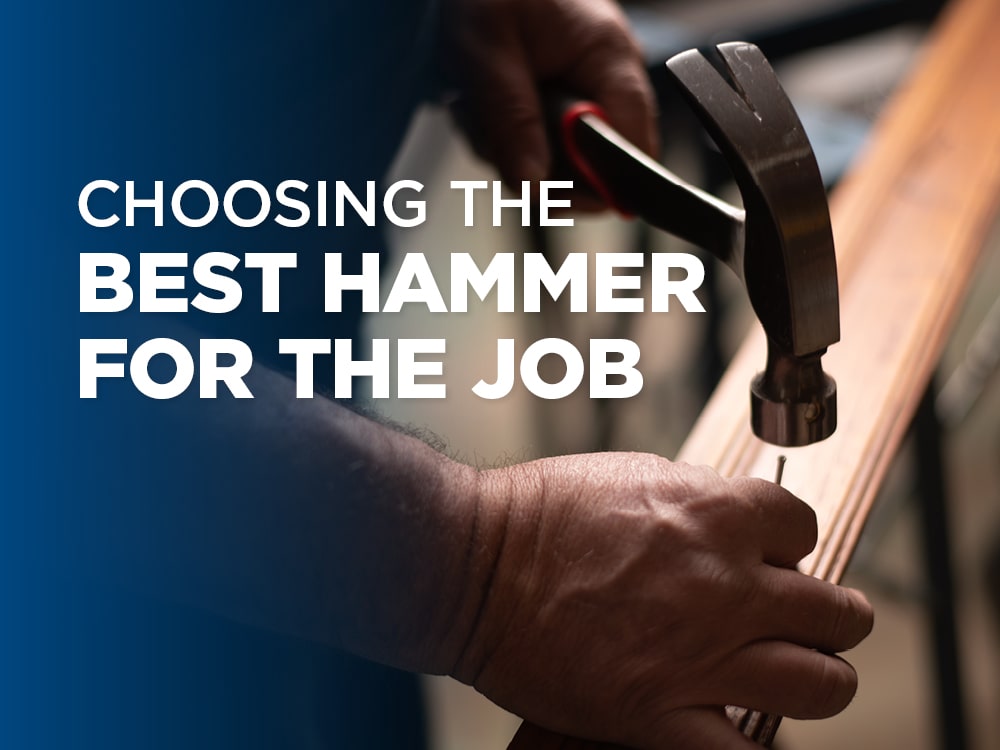- Home
- Loss Control
- Loss Control Insights
- Choosing the Best Hammer for the Job at Hand
Picking up a hammer—whether it’s to pound a nail, mold pieces of metal, rip apart wood components, drive spikes or assemble furniture—seems like an easy task. After all, hammers have been used for centuries for these sorts of jobs, and everyone knows what a hammer looks like.
However, thinking that any hammer will work for any task is a false assumption. Hammers have come a long way from the sharp stone and heavy stick combo you might have seen in cartoons or a museum. Today, there are myriad of highly specialized options.
Hammers are now designed with both safety and sturdiness in mind. Choosing the right tool helps you get the job done quicker, with fewer errors and with less potential for injuries.
Choose the Right Hammer
Examining a hammer’s features and fitting it to your needs will help you successfully complete tasks. Browse available options and consider the shape, size, weight, material and any unique features to determine which options are best suited for you and your job.
It’s often possible to match the task to the tool simply by the name of the hammer. For example, a tack hammer is small and lightweight with a magnetic end to help place small nails and tacks. Below are just some of the common hammer types and the tasks they are designed to complete.
Finishing —
Used for driving small nails and tacks into trim and small wood projects such as cabinet making; head weighs 10 to 14 ouncesNail —
This is the most common hammer type, and it is used for driving and pulling nails as well as general carpentry and chores; head weighs 14 to 20 ouncesFraming (or rip) —
Used for framing work, demolition work and ripping apart wood components; head weighs 18 to 28 ouncesTack —
Used for upholstery and to drive tacks and small nailsSledge —
Used when force is needed; tasks include driving heavy spikes and breaking up concreteBall pein (or peen) —
Used for metalworking, rounding edges, punching and rivetingHand drilling —
Used for pounding nails and masonry drills into concrete or brickSoft-face —
This hammer prevents damage to delicate wood surfaces and are often used to set dowels; faces are composed of plastic, rubber or brassBricklayer’s —
Used for chipping mortar from bricks and setting or splitting bricksRoofing (or shingler’s) —
Used to drive roofing nails and trim shinglesDrywall —
Used to hang or cut drywallWelder’s (or chipping) —
Used for chipping and removing slag when welding; handle is made of a barrel spring that interrupts the flow of heat, keeping the welder’s hand safeMallets —
Used for driving chisels and applying force to delicate areasDrilling —
Also known as a club or engineer’s hammer, this small sledgehammer is used for driving stakes, chiseling and demolitionDead blow —
Used for automotive, dent removal and setting joints because it drives with great force but offers a no-bounce hitLineman’s —
Used to knock around heavy and solid objects to drive them together or apart
Personalize It
Not only do you need to choose the right type of hammer for the job, but you also need to consider features that will best serve you. Most hammers come in a variety of weights and sizes, and they often have several handles types (such as wood, fiberglass or graphite) that may include a slip-resistant feature.
Additionally, there are low-vibration options to minimize impact shock, torsion control stabilizers to reduce arm-twisting fatigue, magnetic nail start for one-handed nailing, ergonomically designed handles, multiple grip positions, textured grip for wet conditions, electrically insulated handles for working on or around exposed energized areas and many other options.
When selecting a hammer, keep these NIOSH recommendations in mind: Choose a hammer that allows all of your fingers to wrap around the grip, and for power tasks, select a handle diameter in the range of 1 1/4 to 2 inches.
Time for a New Hammer?
If your hammer has any of these issues, it’s time to replace it:
- Handle that is rough, cracked, broken, splintered, sharp-edged or loosely attached to the head
- Sharp edges anywhere on the hammer
- A head with dents, cracks, chips, mushrooming or excessive wear
Get in touch
Need help? We’re here for you! Whether you have questions or need personalized assistance, your local office is ready to support you.
Loss Control Insights
Stay informed with the latest news and receive actionable safety tips, all carefully curated by our team of experts.
